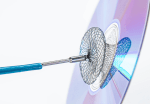Coronary artery disease, both obstructive and non-obstructive, often coexists with significant aortic stenosis. Therapeutic decision-making in this scenario remains controversial, not only regarding the need for treatment, but also about when it should be addressed, considering its pros and cons. Various analyses have yielded contradictory data, as most lesions are chronic and stable. Currently, the...
Left Atrial Appendage Closure and Concomitant Transcatheter Intervention: Can We?
Several scientific societies support performing left atrial appendage occlusion (LAAO) as a stand-alone procedure, even though it is often associated to other cardiomyopathies requiring transcatheter intervention. Though still controversial, combining LAAO and any other cardiac intervention might reduce hospitalizations, as well as the need for additional punctures, anesthesia, red tape, a longer stay and higher...
Structural Summit 2024 – Deadline Extended: One More Week to Submit Your Work
The Structural Summit 2024 is around the corner, and from SOLACI we invite the whole Latin American interventionist community to take part in our Call for Science and submit their work to this important event. In this edition, the winners will receive important awards among which there is a full grant to attend SOLACI-CACI 2024...
SOLACI-CACI 2024 Call for Papers Is Now Open. Send Your Work Now
Submit your scientific papers and challenging clinical cases for SOLACI-CACI 2024 Congress, which marks SOLACI’s 30th anniversary! The best papers and cases will be published in leading indexed PubMed Journals (CRT & MINERVA). Additionally, if your work is selected, your registration fee will be waived! Year after year, SOLACI Congress receives hundreds of submissions from all corners of...
Benefit of Cusp overlap method for self‐expanding transcatheter aortic valves
The need for permanent pacemaker implantation (PPM) continues to be one of the main challenges in TAVR, especially with self-expanding valves, with a pacemaker implantation rate that varies between 17.5% and 30% in large randomized studies, vs. 4% to 6.5% with self-expanding valves. Therefore, in an attempt to prevent the need for PPM implantation, the...
Does Post-Dilation in TAVR Affect its Long-Term Outcomes?
Transcatheter aortic valve replacement (TAVR) has widely demonstrated its significant benefits, both in high-risk and inoperable patients, as well as in those with intermediate and low risk. While paravalvular regurgitation has been a challenge, its management has improved with operator experience and a deeper understanding of CT angiographies. However, in cases of regurgitation, elevated gradient,...
Promising Results of Transcatheter Mitral Valve Replacement in Bioprosthesis Failure
Failure of a mitral bioprosthesis always poses a challenge regarding decision-making, especially when dealing with elderly patients with multiple risk factors. The scenario is worsened by the high risk associated with a new sternotomy and the significant impact of undergoing new surgery. Transcatheter mitral valve-in-valve (TMViV) replacement is emerging as a valid strategy in the...
Events According to Revascularization Modality in the ISCHEMIA Trial
The main studies carried out on patients with chronic coronary syndromes (CCS), such as the MASS II, COURAGE, BARI 2D and FAME-2, failed to show benefits in terms of mortality with the invasive approach. The ISCHEMIA, a large randomized study including patients with moderate to severe ischemia, with without left main disease and with acceptable...
Coronary Artery Disease in TAVR: Unsolved Dilemma
Aortic stenosis shares risk factors with coronary artery disease (CAD), and its prevalence varies according to age, reaching approximately 50% or more in some registries. Deciding when to treat and the need for percutaneous intervention presents a challenge. It has been established that epicardial stenosis at proximal level, or the medial segment, requires intervention, especially...
Clopidogrel Monotherapy Beyond 12 months: Long Term Analysis of the STOPDAPT-2
Short dual antiplatelet therapy (DAPT) has shown benefits in patients receiving drug eluting stents (DES), reducing bleeding with no concomitant increase in major adverse cardiovascular events (MACE). Traditionally, the therapeutic window was limited to monotherapy with P2Y12 inhibitors during the first year and there are few data on short DAPT followed by long term monotherapy...









